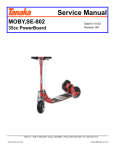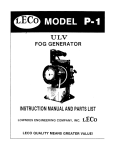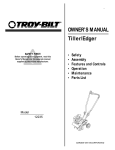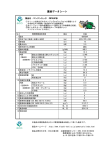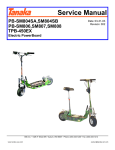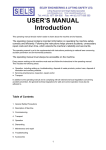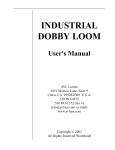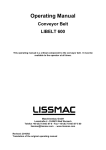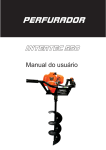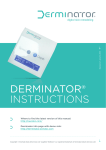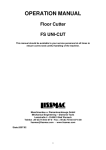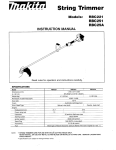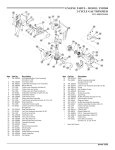Download Service Manual - Golden Eagle Bike Engines
Transcript
Service Manual PF-4000 Date 05-01-02 UTILITY ENGINE ISM, Inc. • 1028 4th Street SW • Auburn, WA 98001 • Phone: (253) 333-1200 • Fax: (253) 333-1212 www.tanaka-usa.com [email protected] PF-4000 Service Manual Table of Contents Specification Chart & Torque Limits ………..……………………….2 Trouble Shooting ………………………………...3 Safety and Shop Practices ………………………………...4 Routine Maintenance ………………………………...4 Diagnostic Tools ………………………………...5 General Inspection ………………………………6-8 Engine Repair ……………….……………9-16 Warranty Statement ………………….……………17 www.tanaka-usa.com 1 [email protected] Service Manual PF-4000 Specification Chart PF-4000 Specifications Cylinder Plating Piston Rings Displacement (cc) Horsepower Bore x Stroke (mm) Compression ratio Maximum hp Maximum kw Maximum torque – kg-m (ft. lbs) Maximum RPM Idling RPM Starting System Rotation (recoil side) Fuel capacity – cc (fl. oz) Fuel consumption – g/hp.hr (g/kw.hr) Carburetor Clutch Diameter Spark Plug Ignition System Spark Plug Electrode Gap Second Coil Resistance Coil Air Gap Engine Dimensions – LxWxH (mm) Engine Weight – kg (lbs) Chrome 2 39.8 1.8 39.8 x 32 7.2:1 1.8 @ 7500 rpm 1.14 @ 8000 rpm 0.21 (1.5) @ 5500 rpm 11000 3000 +/- 200 Recoil Clockwise 1000 (33.8) 345 (469) WYJ-224, Walbro 76 mm CJ7 (Champion) / BM7A (NGK) TCI .024 5.8 KΩ .014 / .016 170 x 260 x 270 3.9 (8.6) Torque Limits In. - Lb. N - M 40 4.5 Crankcase 40 4.5 Cylinder 45 5.0 Carburetor Insulator 38 4.2 Carburetor 200 22.5 Clutch Shoes 185 20.8 Flywheel 25 2.8 Ignition Coil 150 16.8 Spark Plug 25 2.8 Pawl Carrier 35 3.9 Fan Case 50 5.6 Muffler www.tanaka-usa.com 2 [email protected] Service Manual PF-4000 Trouble Shooting Engine Will Not Start Check Function of: Rewind Starter Ignition System: No Spark Fuel System : Fuel Tank Fuel System : Carburetor Air Filter Exhaust System Compression Page No. ………………6, 10, 11 …………...7, 8, 11, 12 …………...6, 8, 12, 13 ………………8, 12, 13 ……………………….6 ………………7, 14, 15 ……………………….7 Check Function of: Clutch System Ignition System: Spark Plug Ignition System: Poor Spark Fuel System : Fuel Tank Fuel System : Carburetor Air Filter Exhaust System Compression Page No. ……………………….9 …………………….7, 8 ………………8, 11, 12 …………...6, 8, 12, 13 ………….7, 12, 13, 14 ……………………….6 ………………7, 14, 15 ……………………….7 Check Function of: Clutch System Ignition System: Poor Spark Fuel System : Fuel Tank Fuel System : Carburetor Air Filter Exhaust System Compression Page No. ……………………….9 ………………8, 11, 12 …………...6, 8, 12, 13 ………….7, 12, 13, 14 ……………………….6 ………………7, 14, 15 ……………………….7 Check Function of: Ignition System: No Spark Fuel System : Fuel Tank Fuel System : Carburetor Compression Page No. …………...7, 8, 11, 12 …………...6, 8, 12, 13 ………………8, 12, 13 ……………………….7 Engine Idles Poorly Engine Lacks Power Engine Stops Suddenly www.tanaka-usa.com 3 [email protected] PF-4000 Service Manual Safety & Shop Practices o The most successful and profitable service shops consistently seem to maintain the best habits of safety, cleanliness, and orderly procedure. The following information is intended as a guide towards developing habits that are necessary to accomplish satisfactory service work. o Maintain a clean and orderly work area that is well lighted and adequately ventilated. o Tools, instruments, and parts needed for work should be clean and readily available before any job is started. (Special tools available for servicing TANAKA equipment are listed in this manual.) o Equipment should be cleaned before repair work starts. Cleaning will often help reveal a source of trouble. o Before attempting to repair or operate any equipment, read and understand all information provided by the instruction manual for the equipment. o Never attempt to service an engine that is running or still heated from running unless it is specifically required by the manufacturer’s instructions. o Wipe-up all spilled liquids immediately. Use non-flammable solvents for cleaning. Clean all parts before reconditioning or reassembling. o Thoroughly inspect all parts for wear or damage. Replace all parts that show damage or excessive wear. o Always recondition and /or repair equipment strictly according to the Manufacturer’s specifications. o Be sure all shields and safety devices are correctly installed before performing any final operating tests. o After completion of any service or repair, the equipment should be thoroughly cleaned. Routine Maintenance Guide Each Use 20 Hrs. 25 Hrs. 100 Hrs. Clean O Air Filter Tighten O All Fasteners Clean O Cooling Fins Clean O Spark Arrestor Clean O Fuel Filter Clean O Spark Plug O Muffler & Exhaust Ports Clean www.tanaka-usa.com 4 [email protected] Service Manual PF-4000 Diagnostic Tools Compression Gauge Pressure Tester Part No. 27286 Part No. 070-2000W-500 Ohmmeter (Digital Type) Engine Tachometer (Digital Type) Three Point Spark Tester Part No. 001-29000-000 Disassembly & Assembly Tools Flywheel Remover Set 1. Handle (006-29326-002) 2. Center Bolt (007-29326-000) 3. Flywheel Puller (006-2932-002) 4. Bolts (021-29355-00) Pin Remover Part No. 009-29326-00 www.tanaka-usa.com 5 [email protected] PF-4000 Service Manual General Inspection Once the engine is removed from the equipment, this is an ideal time to inspect for damage as well as potential areas that may require repair. Some of the diagnostic evaluation cannot be effectively performed after disassembly has begun. Cover, Shroud, Fan Case Inspect covers, shrouds, and fan case to identify damage or cracks due to vibration, ground contact, etc. All of the shroud components are designed for routing the flow of cooling air around the engine. Any broken or missing components could lead to over heating of the engine during operation. Order replacements as need. Inspect the rubber spark plug boot for any damage that may cause a potential shock hazard. Ensure that the fuel tank is not damaged in any way due to possible ground contact, excessive vibration, etc. Any potential fuel leaks may be apparent during this initial inspection, as the exposed fuel on the engine components may attract dirt. This provides a good visual reference. Recoil Starter Ensure that the engine turns freely when the recoil starter is pulled, and that the recoil starter rope retracts positively into the starter housing. Fuel If gasoline is present in the fuel tank, take the opportunity to empty it into a clear container. This may reveal contamination such as water, (as depicted in the photo – phase separation of gasoline and water is very obvious), sediment, or the lack of two-cycle oil/fuel mixture. Air Cleaner Remove the air cleaner cover, and inspect the air cleaner element (A). Ensure that it is clean and lightly oiled. Make sure the inside of the housing that accommodates the cleaner element is free of dirt and dust. The vented area of the crankcase, visible in the photo between the fuel tank and the air cleaner body (B), allows air from the flywheel fins to be circulated to the exterior of the engine and is critical to proper cooling. Ensure that there is no debris within the vent fins that would impede the circulation of air. www.tanaka-usa.com 6 [email protected] PF-4000 Service Manual General Inspection Cont. Choke Lever Check to ensure that the choke lever (A) is able to rotate freely within the air cleaner body, and that it has not been bent as to prevent a good seal when closing over the air intake. Spark Arrestor Screen Remove the spark arrestor retaining screw and holder. Remove any carbon deposits from the screen. If the screen has heavy deposits of carbon build-up, replace it with a new part. Spark Plug Remove the spark plug rubber protection boot and high-tension lead, and remove/inspect the spark plug. Picture A depicts a spark plug that has a broken insulator. Picture B depicts a spark plug that has fouled due to a rich fuel/oil mixture. Picture C depicts a plug that has fouled due to carbon build-up. All of these conditions will prevent the spark plug from functioning properly, and will require replacement. Picture D depicts a plug characteristic of healthy running conditions. The electrode should have a golden/tan color, and no damage is present. Whenever the integrity of a spark plug comes into question, it should be replaced. Whether the plug to be installed is new, used or cleaned, it should be checked for correct electrode gap, which is .024”. Cylinder Compression Insert a compression gauge into the empty spark plug hole and pull the recoil starter handle briskly several times, until the needle on the gauge stops climbing. This reading represents the compression in the cylinder, and is a good gauge of the piston rings ability to hold pressure. The unit will struggle to run with compression less than approximately 90 psi. Such low readings indicate the need for service to the cylinder, piston or piston rings. www.tanaka-usa.com 7 [email protected] PF-4000 Service Manual General Inspection Cont. Spark Testing While the rubber spark plug boot / high-tension lead are removed from the spark plug, this is an ideal time to test the quality of the current being delivered to the spark plug. Insert a three point spark tester into the spark plug boot and briskly pull the recoil starter. The tester should reveal a strong spark with a blue color. Lack of spark, weak spark, or yellow spark may indicate a problem with another electrical component within the engine. Ignition Coil Testing Connect an ohmmeter to the ignition coil with one lead inserted into the spark plug boot and the other making contact with the cylinder fins of the engine (as shown). Secondary resistance, when tested this way, should indicate 5.8 (+/- 1) KΩ. If the reading is not within this range, replace with a new coil, (previous tests for spark using a three point tester should have indicated a weak spark or none at all). If the reading is within range, and still weak or no spark is evident, replace the ignition coil. Fasteners Check to ensure that all fasteners are tight prior to disassembly. Loosening of fasteners on the carburetor side may cause erratic running conditions, or even engine failure. It’s always best to know if fasteners are properly torqued prior to engine service, as problematic running conditions may be the result. Fuel Filter Using a hooked wire, reach into the filler neck of the fuel tank, and grasp the fuel line. Gently pull the fuel line, with the fuel filter attached, through the filler neck. The filter should be white in color and should be compressible between two fingers. If it appears discolored or hard, replace with a new one. www.tanaka-usa.com 8 [email protected] PF-4000 Service Manual Engine Repair ENGINE SERVICE Troubleshooting should alert you to problem areas, and these problem areas can be addressed as major sub-components of the engine: • Centrifugal Clutch • Recoil Starter • Electrical System • Fuel System Components • Exhaust System • Crank Case It is important to properly identify which areas of the engine require service to avoid any unnecessary tear down of components not requiring service. CLUTCH SYSTEM CAUTION: Never attempt to run the engine with the clutch exposed. The clutch is designed to overcome the force of the spring, thus allowing contact with the clutch drum, ultimately providing drive to the PTO side of the equipment. If the clutch is not contained within the clutch drum while the engine is running, the clutch components may come detached from the engine and pose a risk of flying objects. The clutch system is made up of the clutch shoes, clutch spring, and the bolts and washers (flat and waved) securing them to the flywheel. Using an impact wrench or a sharp blow to a socket wrench, remove the bolts securing the clutch to the flywheel (right hand threaded, counter-clockwise for removal.) This will enable all of the components to be inspected. Check for any signs of damage to clutch shoes or excessive wear on the lining of the shoes. When new, the shoes have approximately two millimeters of lining. Order spares as needed. Inspect the wave washers mounted between the bolt and the clutch shoes to ensure that they are not cracked and still provide spring tension. Ensure that the spring is not cracked or broken. Replace as needed. When re-installing the clutch components, attach the spring between the shoes then add the bolts with the wave washers. Hold in place with the flat washers between the backside of the clutch arms and the flywheel, and tighten the stepped bolts to 185 in.-lbs. www.tanaka-usa.com 9 [email protected] PF-4000 Service Manual Engine Repair Cont. RECOIL STARTER CAUTION: The recoil spring is wound with significant force. When removed from the starter body, it will rapidly unwind. It is recommended that you wear gloves and eye protection when removing the starter spring. The recoil starter is made up of the rope, spool and rewind spring. On the engine side is the starter pawl and the nut securing it to the crankshaft. If the recoil starter fails to retract the rope, or if the rope is broken or frayed, it will be necessary to disassemble the starter. Remove the small screw located in the center of the rope spool that secures the spool to the starter body. This will expose all of the starter components. Inspect the spool for any sign of warping, cracks or chips. Replace as necessary. Ensure that the rope is not frayed and is tightly secured with knots to both the starter handle and the spool. Inspect the starter body for any cracks or other damage. Replace as needed. Inspect the starter pawl cup and the spring-loaded pawl located within the cup. The pawl pivots on a spring, and should have constant tension keeping it in place. If the starter pawl spring is broken, it will be necessary to replace the pawl cup. The spring is retained within the starter body by the spool as well as clips formed in both ends of the spring. Check to ensure that the spring is not broken, and that the ends are properly installed in the starter body. If the spring shows no signs of breakage, it may not be necessary to remove it from the starter body. When installing a new spring, use caution, as it is wound with significant force. New replacement springs come pre-wound and wrapped with tie-wire. Carefully grasp the spring with needle nosed pliers and hold it oriented in place prior to removal of the tie-wire. With the tie-wire carefully removed, it will be possible to insert the spring into the starter housing. Ensure that the outside end of the spring (A) is properly positioned in the recoil starter housing, and when the spool is placed over the top of the spring, the tab on the inside of the spring (B) is properly located in the provision on the spool. Prior to placing the spool over the rewind spring, apply a small amount of grease to the inner wall of the center hole on the spool. Wind the rope on the spool about three turns counterclockwise, as viewed from the starter pawl side. Install the starter spool into the case, making sure that the spool engages with the inner end of the rewind spring. Install washer and screw holding starter spool in the case. Recoil Starter cont. www.tanaka-usa.com 10 [email protected] PF-4000 Service Manual Engine Repair Cont. Recoil Starter cont. It is necessary to increase the spring tension in the starter prior to use. Rotate the spool counterclockwise several times with the rope hooked into notch (A). Hold the spool to prevent it from rewinding and pull the starter grip out to take up the rope slack. Let the starter rewind slowly. Pull starter several times to check the spring rewind tension. If the starter is not rewinding fully, repeat the process described above. ELECTRICAL SYSTEM The electrical system includes the flywheel (1), the coil (2), high tension lead assembly (3) and the spark plug (4). To remove the flywheel, it is first necessary to effectively stop the piston from moving within the cylinder. This is easiest accomplished by rotating the crankshaft until the piston is on a downward stroke, then inserting several inches of starter rope into the spark plug hole. Upon rising in the cylinder, the piston will contact the rope, and will not be allowed to complete its cycle or crankshaft rotation. This will allow the flywheel-mounting nut to be removed. The flywheel nut is right hand threaded. Removal is in the counter clock-wise direction. With the flywheel nut removed, a flywheel puller can be attached to separate it from its’ press fit to the crankshaft. Align the center bolt of the puller with the indent in the end of the crankshaft, and thread at least two carrier bolts through the puller and into the flywheel. Make sure that at least several threads are utilized in attaching the carrier bolts, as they will bear the load of pulling the flywheel loose. Damage to these threads will require replacing the flywheel itself. With the puller properly attached to the flywheel, use the T-handle to turn the center pivot point until the flywheel comes loose from the crankshaft. Electrical Systems cont. www.tanaka-usa.com 11 [email protected] PF-4000 Service Manual Engine Repair Cont. Electrical Systems cont. Remove the flywheel (refer to page 11 for disassembly procedure), and inspect the integrity of the flywheel keyway, the crankshaft keyway and the key itself. Any deformation of the key or keyways will require replacement of those components. After identifying the integrity of the coil (refer to page 8 for coil testing procedure), or replacing it with a new one, check the air gap between the coil and flywheel (A). Gap should be measured with a feeler gauge and set at 0.014”. FUEL SYSTEM The fuel system consists of the carburetor (1), fuel tank (2), fuel supply line (3), fuel return line (4), fuel filter and fuel tank vent (5). The carburetor is held in place between the air cleaner body and the heat insulator block with two screws that are accessed on the exterior of the cleaner body (with the cover and cleaner element removed). After removing the carburetor, inspect the gasket that mounts between the carburetor and insulator block. Often times a compromised gasket will show signs that it has allowed fuel to escape. Replace all mounting gaskets when servicing the carburetor. Fuel System cont. www.tanaka-usa.com 12 [email protected] PF-4000 Service Manual Engine Repair Cont. Fuel System cont. Using a straight edge such as a metal ruler, check the carburetor insulator for any possible warping. If the insulator shows sign of warping replace it with a new one. Using a carburetor pressure tester, test the pressure-holding ability of the carburetor. Attach the tester line to the intake fitting of the carburetor (not to be confused with the fitting that accommodates the purge bulb return line). The carburetor should hold 7 PSI. Readings less than this indicate a problem within the carburetor. The pump body of the carburetor is held together with four screws. With these screws removed, it will be possible to inspect all of the pump components of the carburetor. Inspect all gaskets and diaphragms to ensure that they have not lost their pliability, and show no signs of cracking or drying. If any of these components are in question, replace all of them with a carburetor repair kit (650-25124-90). Pay careful attention to their position in the carburetor during re-assembly. www.tanaka-usa.com 13 [email protected] PF-4000 Service Manual Engine Repair Cont. CARBURETOR SERVICE The main body of the carburetor consists of the carburetor body (A), the throttle shaft (B) and the throttle wire receiver (C). Two screws secure the throttle wire receiver and the throttle shaft to the carburetor body. While it’s not necessary to remove the throttle valve for inspection, rotate it by hand to ensure that it is able to freely rotate with the carburetor body and that it can reach the full range of motion permitted between the idle adjustment screw and the full RPM stopper on the carburetor body. Any binding should be addressed by blowing forced air into the throttle valve/body area. If it still does not rotate freely, the entire carburetor will need to be replaced. Also ensure that the o-ring mounted to the carburetor body on the air cleaner side is not torn or dried. Replace as necessary. (The o-ring is a component contained within the carburetor repair kit.) The fuel tank is mounted to the crankcase with three screws that extend from underneath the tank, and through the tank-mounting bracket. Additionally, there are three small spacers that fit within the bolt holes in the fuel tank itself. Inspect the tank, tank cap, tank vent and fuel lines for any signs of leakage or damage. Replace as needed. With the fuel supply line disconnected from the carburetor it is possible to check the integrity of the fuel filter. With the tank cap securely tightened, and the clear fuel return line still attached or blocked off, gently shake the tank while partially filled with gasoline. If the filter is allowing gas to flow, the agitation of the fuel in the tank will force fuel up and out of the fuel line. If the fuel filter is in question, replace it. EXHAUST SYSTEM The exhaust system consists of the muffler / catalytic converter (1), heat shield (2) and muffler gasket (1). The muffler is a sealed, non-serviceable unit that houses the catalyst. If the muffler is damaged or the integrity of the catalyst is in question, the entire unit needs to be replaced. Remove the shroud covering the muffler and cylinder. Remove the muffler and inspect the exhaust port and mating portion of muffler for any build of carbon. Carbon build up is a normal occurrence in a twocycle engine, and removal is a matter of routine maintenance. www.tanaka-usa.com 14 [email protected] PF-4000 Service Manual Engine Repair Cont. CRANKCASE / ENGINE When re-assembling the muffler components, be sure that the heat shield is properly installed with the muffler locator tabs properly inserted. The heat shield is crucial to the cooling of the engine, and improper installation can lead to overheating of the engine. The engine components include the crankcase, crankshaft / connecting rod, cylinder, piston and piston rings. Further, the crankcase also contains the main crankshaft support bearings and the crankshaft seals. The cylinder is attached to the crankcase with four screws, which are accessed from the top of the cylinder. With the screws removed, the cylinder will slide off of the crankcase and piston/rings. The piston is attached to the connecting rod with a press-fit wrist pin. Removal of this pin first requires the removal of the piston pin retaining circlips installed in the side of the piston, at either end of the pin. These are removed with a pair of needled nose pliers, and are not re-usable. New spares should be installed upon re-assembly. Crankcase / Engine cont. www.tanaka-usa.com 15 [email protected] PF-4000 Service Manual Engine Repair Cont. Crankcase / Engine cont. With the engine taken down to this level, it is generally accepted that the piston rings should be replaced. They provide the engine with the proper amount of compression, and due to their inaccessibility, it’s best to re-assemble with new rings. However, if servicing requires the removal of the piston, fitting of new rings to the piston should not be done until the piston has been re-assembled to the connecting rod, as the piston pin remover tool can cause damage to the rings. Using a piston pin remover, loop the strap end around the piston with the hole aligned to allow the passage of the piston pin. It may be necessary to insert a small screw between the remover and the piston pin, as the remover may have a smaller diameter than the inside of the piston pin. The crankcase halves are joined with four screws. Removing these screws will allow the entire contents of the crankcase to be exposed. Inspect the main support bearings, if they are in question replace them. Upon re-assembly, install a new crankcase gasket between the halves. Carefully inspect the crankshaft, paying particular attention to the amount of play between the connecting rod and the crankshaft pin. Side-to-side play (A) is normal. However, any detectable play in an upand-down motion (B) is unacceptable. This indicates the need for a replacement crankshaft. The connecting rod and crankshaft are one, non-serviceable part. www.tanaka-usa.com 16 [email protected] PF-4000 Service Manual WARRANTY STATEMENT Tanaka Kogyo Co., Ltd. ("Tanaka") hereby warrants its utility engines to be free from defects in material or workmanship for a period of 180 DAYS after delivery to the first consumer end user in a non-commercial application. All components on PureFire engines related to the emission control system will carry a 2 YEAR warranty. In the event that the product is used for "commercial", "rental" or "competition" purposes, the warranty shall be VOID. All Tanaka supplied accessories, attachments, and replacement parts will carry a 90 DAYS part replacement warranty. This warranty is limited to repair or replacement, by Tanaka or at the premises of Tanaka Authorized Service Dealers, of such parts as appear to Tanaka, upon inspection, to be defective in material and/or workmanship. The above warranties are extended to the first end user, and no warranty is made, nor authorized to be made assignable, on resale by the first end user. Tanaka makes no warranty with respect to accessories or replacement parts not manufactured by Tanaka or sold by it. Such items are subject to the warranty policy of their respective manufacturers. For the name and address of your nearest Authorized Tanaka Service Dealer, call or write Tanaka c/o International Sales & Marketing Inc. at 1028 4th Street S.W., Bldg. "B", Auburn, WA 98001 (253) 333-1200 or visit their website: www.tanaka-usa.com. To obtain performance of any obligation under this warranty for failure during the applicable warranty period, deliver the Tanaka product, shipping prepaid, to Tanaka c/o International Sales & Marketing Inc., or to the nearest Tanaka Authorized Service Dealer. Tanaka reserves the right to inspect the claimed defective part(s) to determine if the malfunction is the result of a defect covered by this warranty. This warranty will cover only defects arising under normal usage, and shall not apply, nor will Tanaka assume any responsibility, if the failure was caused by the following: 1. Operation of product with incorrect fuel to oil ratio. 2. Misuse or abuse. 3. Negligence. 4. Accident or physical damage. 5. Repairs made by unauthorized parties and/or with unauthorized parts. 6. Improper set up or altering the engine. 7. Improper adjustments (e.g. carburetor, etc.) 8. Operation of engine speeds above Tanaka recommendations. 9. Failures due to contaminated fuel. 10. Failure to operate the unit in the manner specified by the "owner's manual". 11. Use of non-approved accessories or attachments or anything that alters the emission control system. Normal maintenance of the fuel system, spark plug, spark arrester or air filter; adjustments to the carburetor or replacement of wear items such as clutch components are not considered the responsibility of Tanaka under this warranty. THIS LIMITED WARRANTY IS IN LIEU OF ALL OTHER EXPRESS WARRANTIES, OBLIGATIONS, OR LIABILITIES. ANY IMPLIED WARRANTIES, OBLIGATIONS, OR LIABILITIES INCLUDING, BUT NOT LIMITED TO, ANY IMPLIED WARRANTY OF MERCHANTABILITY SHALL BE LIMITED IN DURATION TO THE APPLICABLE WARRANTY PERIOD (AS STATED PREVIOUSLY). ANY ACTION FOR BREACH OF ANY WARRANTY HEREUNDER INCLUDING, BUT NOT LIMITED TO, ANY IMPLIED WARRANTY OF MERCHANTABILITY MUST BE BROUGHT WITHIN A PERIOD OF SIX MONTHS FROM THE END OF THE APPLICABLE WARRANTY PERIOD. Some states do not allow limitations on how long an implied warranty lasts, so the previously stated limitations may not apply to you. No agent, representative, dealer, or employee of Tanaka or International Sales & Marketing Inc. has the authority to increase or alter the obligations of this warranty. IF THE PRODUCT IS USED IN A COMMERCIAL OR COMPETITIVE ENDEAVOR, TANAKA WILL NOT BE LIABLE FOR GENERAL DAMAGES INCLUDING BODILY INJURIES, EXCEPT AS SET FORTH ABOVE, OR FOR INCIDENTAL OR CONSEQUENTIAL DAMAGES INCLUDING, BUT NOT LIMITED TO, LOSS OF USE, LOSS OF PROFITS, LOSS OF PRODUCTION, EXPENSE OF SUBSTITUTE EQUIPMENT OR OTHER COMMERCIAL LOSS OR DAMAGE. THE SAME LIMITATIONS SHALL APPLY TO A PRODUCT USED FOR CONSUMER PURPOSES WITH RESPECT TO ALL NON-PERSONAL INJURY, GENERAL INCIDENTAL AND CONSEQUENTIAL DAMAGES. Some states do not allow the exclusion or limitation of incidental of consequential damages, so the above limitation or exclusion may not apply to you. This warranty gives you specific legal rights, and you may also have other rights which vary from state to state. THE CALIFORNIA AIR RESOURCES BOARD AND TANAKA KOGYO CO., LTD. (TANAKA) ARE PLEASED TO EXPLAIN THE EMISSION CONTROL SYSTEM WARRANTY ON YOUR TANAKA ENGINE. NEW SMALL OFF ROAD ENGINES MUST BE DESIGNED, BUILT AND EQUIPPED TO MEET STRINGENT CALIFORNIA ANTI-SMOG STANDARDS. TANAKA MUST WARRANT THE EMISSION CONTROL SYSTEM ON SMALL OFF ROAD ENGINE FOR THE PERIODS OF TIME LISTED BELOW, PROVIDED THERE HAS BEEN NO ABUSE, NEGLECT OR IMPROPER MAINTENANCE OF YOUR LAWN AND GARDEN EQUIPMENT ENGINE. YOUR EMISSION CONTROL SYSTEM INCLUDES PARTS SUCH AS THE CARBURETOR, THE IGNITION SYSTEM AND THE CATALYTIC CONVERTER (WHICH IS INCORPORATED IN TO THE MUFFLER ON THIS ENGINE). WHERE A WARRANTABLE CONDITION EXISTS, TANAKA WILL REPAIR YOUR ENGINE AT NO COST TO YOU INCLUDING DIAGNOSIS, PARTS AND LABOR. MANUFACTURER'S EMISSION CONTROL WARRANTY COVERAGE: THE EMISSION CONTROL SYSTEM ON 1995 AND LATER SMALL OFF ROAD ENGINES ARE WARRANTED FOR TWO YEARS. IF ANY EMISSION RELATED PART ON YOUR ENGINE IS DEFECTIVE, THE PART WILL BE REPAIRED OR REPLACED BY TANAKA. OWNER'S WARRANTY RESPONSIBILITIES: AS THE SMALL OFF ROAD ENGINE OWNER, YOU ARE RESPONSIBLE FOR THE PERFORMANCE OF THE REQUIRED MAINTENANCE LISTED IN YOUR OWNER'S MANUAL. TANAKA RECOMMENDS THAT YOU RETAIN ALL RECEIPTS COVERING MAINTENANCE ON YOUR SMALL OFF ROAD ENGINE, BUT CANNOT DENY WARRANTY SOLELY FOR THE LACK OF RECEIPTS OR FOR YOUR FAILURE TO ENSURE THE PERFORMANCE OF ALL SCHEDULED MAINTENANCE. AS THE SMALL OFF ROAD ENGINE OWNER, YOU SHOULD BE AWARE, HOWEVER, THAT TANAKA MAY DENY YOU WARRANTY COVERAGE IF YOUR SMALL OFF ROAD ENGINE OR A PART HAS FAILED DUE TO ABUSE, NEGLECT, IMPROPER MAINTENANCE OR UNAPPROVED MODIFICATIONS. YOU ARE RESPONSIBLE FOR PRESENTING YOUR SMALL OFF ROAD ENGINE TO A TANAKA SERVICE CENTER AS SOON AS A PROBLEM EXISTS. THE WARRANTY REPAIRS SHOULD BE COMPLETED IN A REASONABLE AMOUNT OF TIME, NOT TO EXCEED 30 DAYS. IF YOU HAVE ANY QUESTIONS REGARDING YOUR WARRANTY RIGHTS AND RESPONSIBILITIES, YOU SHOULD CONTACT TANAKA C/O INTERNATIONAL SALES & MARKETING, INC., CUSTOMER SERVICE DEPT. AT (253) 333-1200. www.tanaka-usa.com 17 [email protected]


















